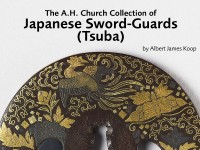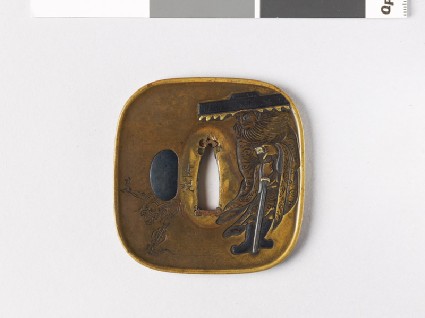The A. H. Church Collection of Japanese Sword-Guards (Tsuba)
An unpublished catalogue of the A. H. Church collection of Japanese sword-guards (tsuba) by Albert James Koop.

Publications online: 1264 objects
Tsuba depicting Shōki and a demon
-
Literature notes
Thick; nearly square, with rounded angles; edge very regularly hammered up; in sunk relief, with iroye incrustation, is a large figure of Shōki (see 935) [EAX.10935], who stands leaning on his drawn sword and looking down at a terrified oni (engraved) who has stolen his fan; the lower part of the oni is represented at the back, the idea being that, while halfway through the kodzuka-hole, the demon has been made a prisoner by the insertion of the shakudō plug; also at the back are clouds in katakiri. Signed: Shigechika [Japanese text]. (Unrecorded.) -
Details
- Associated place
- Date
- c. 1800
- Material and technique
- obverse and reverse: sentoku, with hammered-up edge; shakudō kozuka-hole plug; tang-hole plugged with soft metal, probably copper obverse: with iro-e zōgan (multi-metal inlay) decoration, and engraved decoration reverse: with katakiri engraving (oblique chisel-cuts), and engraved decoration
- Dimensions
- 7.5 x 7.3 x 0.6 cm (height x width x depth)
- Material index
-
processed material › metal › alloy › sentoku,processed material › metal › alloy › copper alloy › shakudō,
- Technique index
- Object type index
-
arms/armour › koshirae › kodogu › tsuba
- No. of items
- 1
- Credit line
- Bequeathed by Sir Arthur H. Church, 1915.
- Accession no.
- EAX.10953
-
Further reading
Koop, Albert James, The A. H. Church Collection of Japanese Sword-Guards (Tsuba), 3 vols (Oxford, Ashmolean Museum, 1929), no. 953
Glossary (5)
Shōki, kozuka, sentoku, shakudō, tsuba
-
Shōki
Zhong Kui, or Shōki in Japanese, is a figure from Chinese folklore who appeared to the ailing 8th century Chinese Emperor Xuanzong in a dream and dispatched the demons that were haunting him. Shōki promised the Emperor that he would rid the world of demon
-
kozuka
The handle that holds the small knife called the kogatana.
-
sentoku
A kind of brass made from an alloy of copper, zinc, and tin.
-
shakudō
alloy of copper and gold, patinated to a dark blue-black colour
-
tsuba
Japanese sword guard.
Location
-
- currently in research collection
Objects are sometimes moved to a different location. Our object location data is usually updated on a monthly basis. Contact the Jameel Study Centre if you are planning to visit the museum to see a particular object on display, or would like to arrange an appointment to see an object in our reserve collections.
Publications online
-

The A. H. Church Collection of Japanese Sword-Guards (Tsuba)
Thick; nearly square, with rounded angles; edge very regularly hammered up; in sunk relief, with iroye incrustation, is a large figure of Shōki (see 935) [EAX.10935], who stands leaning on his drawn sword and looking down at a terrified oni (engraved) who has stolen his fan; the lower part of the oni is represented at the back, the idea being that, while halfway through the kodzuka-hole, the demon has been made a prisoner by the insertion of the shakudō plug; also at the back are clouds in katakiri. Signed: Shigechika [Japanese text]. (Unrecorded.)
Notice
Object information may not accurately reflect the actual contents of the original publication, since our online objects contain current information held in our collections database. Click on 'buy this publication' to purchase printed versions of our online publications, where available, or contact the Jameel Study Centre to arrange access to books on our collections that are now out of print.
© 2013 University of Oxford - Ashmolean Museum

